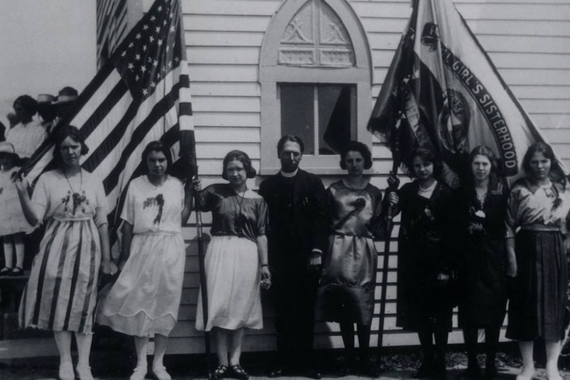Message for IHRC Acting Director
This political present is excruciating.
The current administration’s attacks on immigrants and refugees are unrelenting. Many of us watch this moral and political degeneracy carried out through the coordinated exercises of state power and white nationalist subjects aghast. We certainly do not need to hear from the FBI to confirm, particularly in the wake of the Pittsburgh synagogue shooting, which occurred on the heels of the midterm elections, what we all know to be unequivocal—“hate is on the rise.”
A week before Election Day, Trump assailed our conscience with provocation to end birthright citizenship with an executive order, a direct assault on the 14th Amendment. The administration’s posturing to fleece the cornerstone of American democracy, the crown jewel of a long struggle against slavery in this country, the Black tradition of abolitionism, is a clear-cut warning. It indexes the consolidation of power by the wealthiest and their political advisors, not just the world’s one percent, but also the one percent in every state, metropolitan area, and county across the country. Knowing full well powerful business interests’ abhorrence toward social democracy, it is hard to dismiss his vitriol as yet another move drawn from the playbook called Trumpism. Unceasing, a week after the midterm elections, responding to the refugee caravans from Honduras traversing toward the U.S.-Mexico border, Trump issued the proclamation to deny these refugees the right to asylum for at least 90 days in the name of defending the national interest. He is, indeed, “dreaming up another immigration crisis,” as the recent New York Times editorial reads.
But this condemnation misses the mark. The reality is that the significant number of the populace, far from monolithic, is dreaming up, too. Trump’s supporters are diverse. They are the affluent, evangelicals, small shopkeepers and business owners, retirees, the self-employed, private-sector workers in the unionized and non-unionized workforce, independent contractors, office workers, chain-store employees, farmers and their local suppliers, and many more who reside in towns and suburbs, big and small, including in areas where voters swung from supporting Obama to pro-Trump. What these Americans of varying economic backgrounds who are mostly white share in common is perceived status threat at home and on the global stage. Raising the banner of whiteness cloaked as the national interest, they are holding down the fort. Their opposition to immigrants and refugees, in the end, strengthen the intraclass alliance, even as many of them who are part of Trump’s broad coalition actually live through financial strains and social miseries largely due to the widening wealth gap catalyzed by the one percent. This irony, no doubt, makes race, especially the cause and consequence of constructing whiteness, a fundamental factor behind the politics of “dreaming up” from above and below. And precisely because of this tenaciousness of the white problem, race is not a detour, but a main highway, if the urgent task is to devise strategies to bring about a more just, egalitarian, and humane society.
Surely, this fear-driven contempt directed at immigrants and refugees, combined with the persistence of anti-black racism, does the work of conjuring. It brings into existence the spectacle of “the rising tide of color” threatening what is considered to be sacrosanct. In our times, discourse on the national interest is the genie out of the bottle. In the past, more than a century ago when Chinese immigrants, and later other Asian immigrant workers were wholesale targeted as the curse of American labor, cheap labor, the debate over the “American standard of living” performed the similar ideological function. The pamphlet penned by Samuel Gompers, the leader of the American Federation of Labor, which was reprinted and widely circulated by the Asiatic Exclusion League in 1908, encapsulated, in a stark dualism, the existential threat of white workers and their deep anxiety. The message was framed in terms of their right to consume—“Meat vs. Rice: American Manhood against Asiatic Coolieism: Which Shall Survive?”—the trapping of commodity fetishism that amplified the alienated quality of their life.
In The Indispensable Enemy: Labor and Anti-Chinese Movement in California, the great historian, Asian American studies scholar, and novelist Alexander Saxton (1919-2012) chronicled this politics of race, as it unfolded in statewide workers’ struggles. He paid close attention to the formation of the Workingmen’s Party in 1877-78 and the socialist tendency in the 1880s. Saxton dramatized the tragedy of American labor. Dreaming up Chinese labor as a threat to American freedom, trade unionists participated in electoral politics and tapped into the ideological mainspring of 19th-century populism, specifically Jacksonian democracy, the political and cultural authority of white settler nationalism that was the nucleus of Andrew Jackson’s genocidal policy against the Indigenous nations of the Southeast, which in turn enriched the slaveholding class. Saxton explained that in the popular campaign against the Chinese in the 1870s and 1880s, “racial identification cut at right angles to class consciousness,” thereby facilitating the formation of the government of human life by American capital and white polity committed to political disenfranchisement, human degradation, plunder, and war-making, all of which, in the end, forestalled the struggle for social democracy. In his characteristically penetrating critique of American freedom, James Baldwin made it plainly clear: “whatever it is that white Americans want, it is not freedom—neither for themselves nor for others.”
Saxton’s book is indispensable, if we want to wake up from the political present and start the work of freedom. Perhaps this picture, taken on May 10, 1869, of a gathering to celebrate the completion of the first transcontinental railroad at Promontory in Utah serves as a sharp reminder. The crowd of mostly American business and political leaders and just a sprinkle of laborers standing in the back, all white men, is embracing this historic occasion. Absent are Chinese immigrant workers, “the indispensable enemy” of the American working class. Thousands of Chinese immigrants laid the tracks for the Central Pacific Railroad. They represented 80% of its workforce, and many perished laboring under harsh conditions.
In the end, Saxton never lost sight of the road not taken to fulfill the promise of emancipation, which he identified in a singular working class hero, Sigismund Danielewicz. He was a Polish Jew, a member of the historically persecuted, who was a lone voice at odds with the assertion of whiteness at the height of the anti-Chinese movement in California. He rebuked it. He was also a seaman, the leader of the Sailors’ Union of the Pacific active in the struggles of labor in the American West. “He might have had ships and high schools—even union halls—named for him,” Saxton wrote, “except that he chose to stand for the principle of interracial equality.” He held tight to Danielewicz’s principled stance, which, he noted, was derived from “a tradition of humane and humanist radicalism in America.” The pulse of this tradition needs to be seized, and fighting for immigrants’ and refugees’ rights is of vital importance if we are to reinvent this tradition for the political present.


